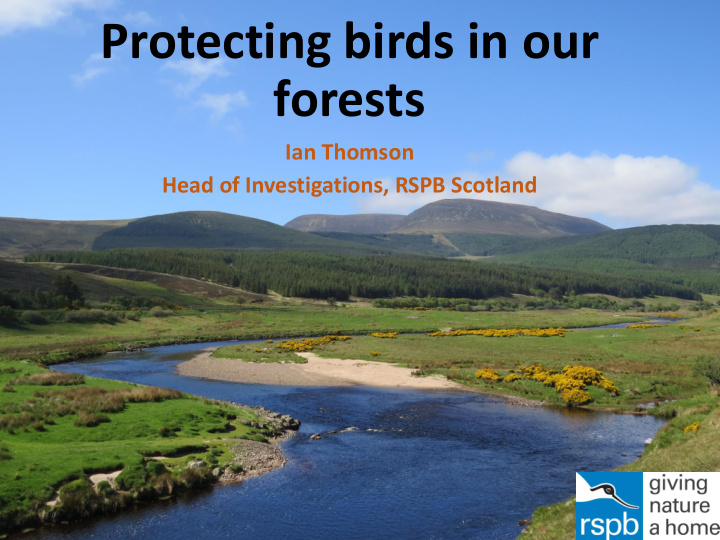



Protecting birds in our forests Ian Thomson Head of Investigations, RSPB Scotland
• Despite Scotland being the most wooded of the UK countries, with around 19% woodland cover, it remains one of the most heavily deforested countries in Europe, with woodland cover well below the current European average of 37%. • Just under a quarter (311,000ha) of Scotland’s woodland is considered native. • This includes globally important areas of Atlantic rainforest, including Oak and Hazel woodland, and Caledonian pine forest – widely recognised as being of very high value to biodiversity, but fragmented and restricted in range. • The remaining three-quarters (1.4 million ha) is mainly commercial forestry plantation dominated by conifers, which benefit a smaller range of largely generalist species
So what laws protect the birds in our forests?
1981 Wildlife & Countryside Act as amended by the 2004 Nature Conservation (Scotland) Act and the 2011 Wildlife and Natural Environment Act But also: General Licences (issued annually by Scottish Natural Heritage) Possession of pesticides (Scotland) Order 2005 Food & Environment Protection Act (1985) Control of Pesticides Regulations 1986 Agriculture (Scotland) Act 1948 as amended by the Pests Act 1954 Spring Trap Approval Order (Scotland) 2011 (as amended) The Control of Trade in Endangered Species (Enforcement) regulations 1997 Etc, etc…..
The Law: All wild birds are protected.... ...but some are more protected than others!
It is illegal to - intentionally or recklessly: • kill, take or injure any wild bird (except permitted species outwith close season, or those included on Scottish Government general licence) • take, damage or destroy any egg or nest • disturb any bird or nest of a bird included in Schedule 1 of the WCA. • disturb any wild bird included in Schedule 1 of the WCA as it uses a lek (ie Capercaillie) • harass any wild bird included in Schedule 1A of the WCA (Golden eagle, WT eagle, red kite, hen harrier)
Three sources of potential wildlife crime in forests Forest operations: disturbance or damage Recreation: disturbance or damage Deliberate targeting: disturbance, damage, illegal killing
What is disturbance? No simple definition, but potential adverse impacts include: • nest desertion • increase predation risk to eggs, chicks or adults • preventing the use of an area for feeding • disruption of lekking or roost sites
Accidental damage or disturbance from forest operations is often the result of: • poor planning • inexperienced surveyors • ignorance of the law • poor communication between “office” and contractors
forestry.gov.scot/publications/30-forest-operations-and-birds-in-scottish-forests
Reflecting.... How to avoid operational damage or disturbance to breeding birds Forest survey and planning • Knowing what is present in the forest. • Survey for nests particularly in areas where operational disturbance could be significant • Areas to be felled should be of highest priority for survey • Surveying well in advance allows the opportunity to zone management at the earliest possible stage. • From February to August all areas due for thinning and felling should be checked for active nests at least two weeks before operations start.
Some birds are more sensitive than others...
• From 1 Feb to 31 Aug , < 250 m of an active WTE nest, most forestry operations and activities need to be severely restricted to avoid disturbance. • Between 250 m & 500 m of an active WTE nest, some forestry operations may be carried out between 1 Feb & 31 Aug with minimal risk of disturbing the nest • From 1 Sept to 31 Jan, forestry operations & activities up to and around WTE nests may be carried out with little risk of disturbing eagles, ( unless eagles are actively nest-building which sometimes happens in Dec & Jan ). • Roost sites should be protected from disturbance. To avoid this, forestry activities or recreational events within 250 m of an active roost site should be avoided during the period from 2 hours before sunset until 2 hours after sunrise, at any time of year. • Habitually -used nest sites are protected from damage and destruction even when not in use. Foresters should plan operations carefully to avoid damaging or destroying such nests.
4 th March 2009
Care is required in planning location & timing of forest-based leisure events, such as music concerts, mountain bike or orienteering competitions. Irregular events can cause sudden changes in disturbance levels & may cause birds to desert their nests. Participants in events cannot be expected to know what lies in their path, so the onus is on the organisers to plan the event well. If organisers researching routes or locations find nesting species, then amendments should be made following the guidelines for forest operations mentioned previously.
Many species will tolerate frequent background levels of human presence. Walkers, cyclists or horse riders along marked trails, even if they go through nesting territories, can do so without any discernible effects But, uncontrolled dogs can cause significant disturbance
Not all human visitors to our forests have innocent intentions...
Birdwatchers & photographers wanting to get far too close cause disturbance to leks or nests
Egg collecting is still a threat to some nests
Goshawk nest persecution, in a FCS forest.
Most human visitors only leave footprints...
Thank you Ian Thomson RSPB Scotland Investigations Unit 0131-317- 4100 ian.thomson@rspb.org.uk @Ian_M_Thomson
Recommend
More recommend